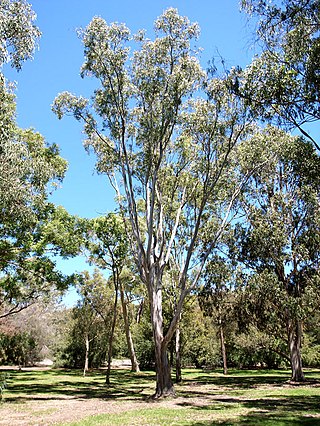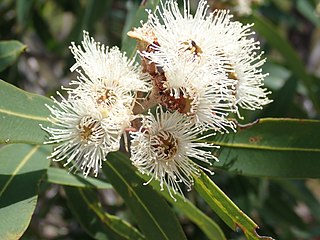
Angophora is a genus of nine species of trees and shrubs in the myrtle family, Myrtaceae. Endemic to eastern Australia, they differ from other eucalypts in having juvenile and adult leaves arranged in opposite pairs, sepals reduced to projections on the edge of the floral cup, four or five overlapping, more or less round petals, and a papery or thin, woody, often strongly ribbed capsule. Species are found between the Atherton Tableland in Queensland and south through New South Wales to eastern Victoria, Australia.

Angophora costata, commonly known as Sydney red gum, rusty gum or smooth-barked apple, is a species of tree that is endemic to eastern Australia. Reaching 30 m (100 ft) in height, the species has distinctive smooth bark that is pinkish or orange-brown when new and fades to grey with age. Its lance-shaped leaves are arranged in opposite pairs along the stems, with white or creamy white flowers appearing from October to December. The flower buds are usually arranged in groups of three, followed by ribbed, oval or bell-shaped fruit.

Eucalyptus flocktoniae, commonly known as merrit, is a species of tree or mallee that is endemic to Western Australia. It has smooth, silvery grey bark, lance-shaped to curved adult leaves, prominently beaked flower buds in groups of seven or nine and barrel-shaped or urn-shaped fruit.

Eucalyptus camphora, commonly known as swamp gum is a flowering plant that is endemic to south-eastern Australia. It is a species of small to medium-sized tree with smooth bark, sometimes rough at the base, broadly lance-shaped to egg-shaped or elliptic adult leaves, flower buds in groups of seven, white flowers and conical fruit. There are two subspecies, subspecies camphora, commonly known as broad-leaved sally or swamp gum and subspecies humeana, commonly known as mountain swamp gum.

Eucalyptus scias, known as the large-fruited red mahogany, is a species of small, straggly to medium-sized tree that is endemic to the high rainfall coastal areas of New South Wales. It has rough, fibrous bark on the trunk and branches, lance-shaped adult leaves, flower buds in groups of three or seven, white flowers and cup-shaped, conical or bell-shaped fruit.

Eucalyptus amplifolia, commonly known as the cabbage gum, is a tree that is endemic to eastern Australia. It has smooth bark on its trunk and branches, lance-shaped leaves, and buds in groups of between seven and fifteen or more. The flowers are white and the fruit are woody hemispherical capsules. It is common on the coastal areas and tablelands of New South Wales and adjacent areas in south eastern Queensland, occurring as far south as Bega.

Angophora bakeri, commonly known as the narrow-leaved apple, is a species of tree that is endemic to New South Wales. It has rough, fibrous bark on the trunk and branches, lance-shaped adult leaves, flower buds in groups of three or seven, white or creamy white flowers and oval to cylindrical fruit.

Angophora bakeri subsp. crassifolia is a small, shrubby tree or mallee that is endemic to a small area of New South Wales. It has rough bark on the trunk and branches, thick, rigid lance-shaped leaves, flower buds in groups of three or seven, white or creamy white flowers and cup-shaped to barrel-shaped fruit. It is similar to subspecies bakeri, differing in its smaller habit, thick leaves and slightly larger fruit.

Angophora subvelutina, commonly known as the broad-leaved apple, is a species of tree that is endemic to eastern Australia. It has rough bark on the trunk and branches, lance-shaped to egg-shaped or elliptical adult leaves, flower buds in groups of three or seven, white or creamy white flowers and ribbed, cup-shaped fruit.

Angophora leiocarpa, commonly known as rusty gum, is a species of small to medium-sized tree that is endemic to eastern Australia. It has smooth bark on the trunk and branches, lance-shaped adult leaves, flower buds usually in groups of three, white or creamy white flowers and smooth barrel-shaped to cup-shaped fruit.

Angophora woodsiana, commonly known as smudgee, is a species of small to medium-sized tree that is endemic to eastern Australia. It has rough bark on the trunk and branches, lance-shaped or curved adult leaves, flower buds in groups of three or seven, white or creamy white flowers and ribbed, cup-shaped fruit.

Eucalyptus effusa, commonly known as rough-barked gimlet, is a species of mallee or small tree that is endemic to Western Australia. It has thin, rough bark on the base of the trunk, smooth bark above, linear to narrow lance-shaped adult leaves, flower buds arranged in groups of seven, white flowers and cup-shaped to conical fruit.
Corymbia deserticola is a species of straggly tree, a mallee or a shrub that is native to Western Australia and the Northern Territory. It has rough, tessellated bark on the trunk and branches, mostly sessile, heart-shaped leaves arranged in opposite pairs, flower buds in groups of seven on each branch of a peduncle, creamy yellow flowers and urn-shaped to shortened spherical fruit.

Corymbia eremaea, commonly known as mallee bloodwood, hill bloodwood and Centre Range bloodwood, is a small, mallee-like tree that is endemic to central Australia. Indigenous Australians know the plant as muur-muurpa. It has rough, evenly tessellated bark, lance-shaped leaves, oval to pear-shaped flower buds arranged on a branching peduncle and urn-shaped fruit.

Corymbia watsoniana, commonly known as large-fruited yellowjacket, is a species of tree that is endemic to Queensland. It has rough, tessellated bark on the trunk and branches, egg-shaped to broadly lance-shaped adult leaves, flower buds in groups of seven, creamy white flowers and barrel-shaped or urn-shaped fruit.

Angophora melanoxylon, commonly known as Coolabah apple, is a species of small to medium-sized tree that is endemic to eastern Australia. It has rough, fibrous bark on the trunk and branches, linear to narrow lance-shaped adult leaves, flower buds in groups of three or seven, white or creamy white flowers and cup-shaped, cylindrical or barrel-shaped fruit.
Eucalyptus pauciflora subsp. acerina, commonly known as snow gum, is a mallee or small tree that is endemic to a small area of Victoria, Australia. It has smooth, shiny bark, glossy green lance-shaped to egg-shaped leaves, flower buds in groups of between nine and fifteen, white flowers and hemispherical or conical fruit. It differs from other subspecies of E. pauciflora in having a dense crown and no parts that are glaucous.

Eucalyptus pauciflora subsp. niphophila, commonly known as snow gum, is a small tree or large shrub that is native to a few mountain peaks in eastern Australia. It has smooth bark, glossy green, lance-shaped to egg-shaped or elliptical leaves, flower buds in groups of between nine and fifteen, white flowers and cup-shaped, hemispherical or conical fruit. It differs from other subspecies of E. pauciflora in having more delicate, pedicellate flower buds and smaller leaves.

Angophora bakeri subsp. bakeri, commonly known as narrow-leaved apple, is a small to medium-sized tree that is endemic to New South Wales. It has rough bark on the trunk and branches, flower buds in groups of three or seven, white or creamy white flowers and cup-shaped to barrel-shaped fruit.
Angophora costata subsp. costata is a species of medium-sized to large tree that is endemic to eastern Australia. It has smooth bark, lance-shaped adult leaves, flower buds in groups of three, white or creamy white flowers and cylindrical to barrel-shaped fruit. It is similar to subspecies costata but has narrower leaves and smaller fruit.















